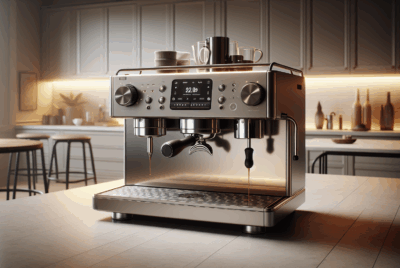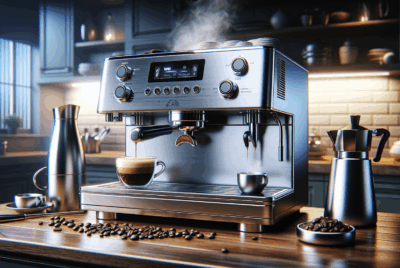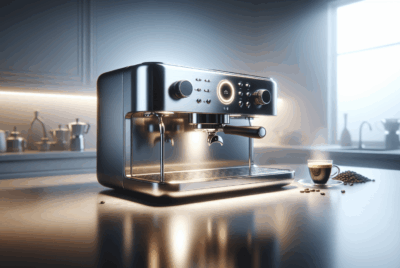Home Barista Tips: The Joy of the Perfect Brew
As an Amazon Associate, I earn from qualifying purchases, at no additional cost to you. Disclaimer
Introduction
Are you a coffee lover eager to transform your coffee-drinking experience from average to exceptional? Maybe impress your friends and family? You’ve landed in the right place. I’m here to share my experiences and suggestions to help you with some outstanding home barista tips.
Why Should You Be Your Own Barista
Embarking on a journey to become your own self-trained barista can be a fun and fantastic experience, bringing with it a multitude of rewards.
Control Over Your Coffee Experience
As your own barista, you’re in full control. You get to choose everything – from the coffee beans, the brewing equipment, the water temperature, to the brewing method. This means you can customize your coffee exactly to your liking. I remember the exhilaration when I first realized that I could dictate exactly how I wanted my coffee to taste. That robust, dark roast for the mornings when you need that extra kick, or perhaps a lighter, fruity roast for a late afternoon pick-me-up? The choice is all yours.
Cost-Effective
While investing in coffee equipment might seem pricey at first glance, think about the long-term savings. Add up the dollars you spend on your daily café trips, and you’ll find it amounts to a substantial sum. By brewing your own coffee, you can significantly reduce your coffee expenses over time. I once calculated that I was spending nearly $1,500 per year on café-bought coffee. By investing in a good coffee machine and grinder, I managed to halve that expenditure.
Learning and Satisfaction
There’s an indescribable satisfaction in mastering the art of coffee brewing. It’s a continuous learning experience, and with each cup, you’ll find yourself understanding more about the intricacies of coffee. At first, I didn’t know much beyond “I like coffee.” Now, I can talk about extraction, grind size, and flavor profiles. And the satisfaction of finally pulling that perfect espresso shot after numerous trials is so gratifying.
Flexibility and Convenience
Brewing your own coffee gives you the flexibility to enjoy a fresh cup at any time of the day, without needing to step out of your home. This was particularly useful during the lockdown when many of us were stuck at home. I relished being able to make a café-quality cappuccino right in my kitchen whenever I felt like it.
Connection and Appreciation
When you become your own barista, you start to appreciate the process and craftsmanship that goes into making a single cup of coffee. From the farmers growing the beans to the roasting process, a lot of hard work goes into what ends up in our cup. It brings about a sense of connection and deeper appreciation for coffee.
Becoming your own barista can be a fulfilling, cost-saving, and educational experience. It gives you the freedom to explore, experiment, and enjoy coffee on a whole new level. So, why not give it a shot?
Starting Your Journey: Essential Equipment
A significant part of this voyage is about acquiring and understanding the essential equipment that goes into making that perfect cup. Let’s take a closer look at the key elements.
Coffee Beans: Importance and Selection
It all starts with the beans – the cornerstone of your coffee experience. Beans come in various roasts and origins, each offering a unique flavor profile. In my early days as a home barista, I used to think all beans were the same. But once I started experimenting with different types, I realized how varied the tastes could be. Freshly roasted beans can impart a richness and depth of flavor that you won’t find in pre-packaged supermarket coffee. Consider purchasing from local roasters, not only to support local businesses but also to ensure you’re getting the freshest roast.
Brewing Equipment: Your Key Tools
Next up is the brewing equipment. From French presses to espresso machines, the options are plentiful. Your choice will depend on your preferences, budget, and how much you’re willing to learn. When I first started, I used a simple French press. It was affordable and easy to use, perfect for a novice like me. Over time, I invested in an espresso machine to broaden my brewing skills and replicate the coffee shop experience at home.
The Grinder: An Essential Component
Perhaps one of the most underrated pieces of equipment is the coffee grinder. Many beginners, including myself at one point, question the necessity of a grinder. But grinding your own beans right before brewing makes an undeniable difference in the freshness and flavor of your coffee. The first time I used a burr grinder, the improved aroma and taste were immediately noticeable. Burr grinders are preferred for their consistent grind sizes, which are crucial for balanced extraction. A good grinder can be a game-changer.
When I first started, I was hesitant to invest in coffee equipment, worrying about the costs and complexity. But with time, I’ve come to realize that you don’t need to go all out from the start. Begin with the basics and gradually upgrade as you become more comfortable and as your love for coffee brewing grows. And trust me, it will grow.
Home Barista Tips: Mastering the Art of Brewing
Once you’ve got your coffee beans and equipment, the next big step is to master the art of brewing. It may seem complex at first, but with a bit of patience and practice, you’ll get the hang of it. Here are the critical elements that contribute to a well-brewed cup of coffee.
Understanding Extraction
Extraction is all about drawing out the flavors from your coffee grounds into the water. Achieving the right balance of extraction is a delicate dance and key to a great cup of joe. The first time I heard about extraction, I was a bit overwhelmed. However, as I started experimenting and tasting, I began to understand its impact. If your coffee tastes too bitter, it may be over-extracted, which means too much flavor has been drawn out. On the other hand, under-extraction can lead to sour or weak coffee. Your grind size, brewing time, water temperature, and the coffee-to-water ratio all play crucial roles in this process.
Dialing In Your Grind
Getting the grind size right is vital for balanced extraction. A fine grind can lead to over-extraction, while a coarse grind can result in under-extraction. The right grind size varies depending on your brewing method. I learned this the hard way when I used a fine espresso grind in my French press, resulting in a muddy, over-extracted brew. It’s a trial-and-error process, but don’t be disheartened. Keep experimenting, and eventually, you’ll find the perfect grind for your favorite brewing method.
The Importance of Water Quality
When I started, I overlooked the importance of water quality in brewing coffee. But did you know that a cup of coffee is 98% water? Hence, the water you use significantly impacts the taste of your coffee. Using filtered or bottled water can enhance the flavor of your brew and prevent scale buildup in your equipment. The first time I switched to filtered water, the improvement in my coffee’s taste was clearly noticeable.
Mastering the art of brewing involves a lot of learning and experimenting. Don’t worry if you don’t get it right the first time. Remember, every mistake, every subpar cup of coffee brings you one step closer to brewing perfection. Keep trying, keep tasting, and keep refining. Before you know it, you’ll be brewing coffee that rivals your favorite coffee shop’s, all from the comfort of your home.
The Espresso: A Deep Dive
One of the most popular and highly regarded forms of coffee is the espresso. A rich, velvety shot of espresso can serve as the base for a variety of drinks, from a simple Americano to a creamy latte. Here, we’ll cover a few more home barista tips and dive deep into the art of making the perfect espresso at home.
Understanding Espresso
The first time I had an espresso shot, I was amazed by the robust flavor packed into such a small cup. Espresso is a concentrated form of coffee, brewed under high pressure. It’s known for its strong taste, thick consistency, and a distinctive layer of crema on top. This depth of flavor is achieved through a careful balance of several factors including grind size, dose, water temperature, and pressure.
Perfecting Your Grind
When brewing espresso, the grind size is finer than most other brewing methods. The first time I made espresso at home, I used a grind that was too coarse. The water flowed through too quickly, resulting in a weak and under-extracted shot. After some trial and error, I found the right grind – fine enough to create resistance but not so fine that it blocks the water flow. It took a while to get there, but the end result was more than worth it.
Getting the Right Dose and Tamping
In the world of espresso, dose refers to the amount of coffee used. I generally start with 18-20g for a double shot, but this can vary based on your preferences and the size of your portafilter. After dosing, comes tamping – pressing down the coffee grounds to create an even surface. An uneven tamp can result in water channeling through certain areas more than others, leading to uneven extraction. I remember my first few attempts at tamping. It felt awkward, but with practice, I learned the right amount of pressure to apply for a level and firm tamp.
Mastering the Extraction
Brewing the perfect espresso is all about the right extraction. Ideally, a shot of espresso should take about 25-30 seconds to brew. If it’s too fast, your espresso may be under-extracted and sour; too slow, and it could be over-extracted and bitter. Timing my shots and making necessary adjustments taught me a lot about the relationship between grind size, dose, and extraction time.
Enjoying Your Creation
One of the most rewarding moments as a home barista, I was pulling that first perfect shot of espresso. The rich aroma, the robust flavor, and the velvety crema were truly a joy to behold. Remember, becoming a home barista is about the journey, not just the destination. So, take your time, experiment, learn, and most importantly, enjoy each cup you brew.
Home Barista Tips: Advanced Techniques
Once you’ve mastered the basics of brewing and pulled your first successful espresso shot, you may want to explore some advanced home barista tip and techniques. These can elevate your home coffee experience and bring you closer to the professional barista world.
Experimenting with Different Coffee Beans
As a home barista, don’t be afraid to explore the vast world of coffee beans. Different beans have unique flavor profiles, and trying them out can be an adventure in itself. I remember when I first ventured beyond my regular beans and tried a single-origin Ethiopian variety. The fruity and floral notes were a delightful surprise. Remember, the beauty of being a home barista is the freedom to experiment and discover what you love.
Mastering Latte Art
Creating beautiful latte art was something I dreamed about when I first started brewing coffee at home. It’s a great way to impress guests and adds a touch of elegance to your drink. Mastering latte art requires practice, but it’s quite rewarding. Start with a simple design, like a heart, and gradually progress to more complex patterns like rosettes or tulips. My first successful heart pattern was a small victory that made my day!
Dialing in Your Brew Ratio
The brew ratio, the amount of coffee used relative to the amount of water, can significantly impact the flavor of your coffee. As an advanced technique, dialing in your brew ratio allows you to fine-tune your coffee to your exact preference. This was a game-changer for me. By slightly tweaking the brew ratio, I could customize the strength and flavor of my coffee.
Exploring Alternative Brewing Methods
As a home barista, there’s a world of brewing methods to explore beyond the espresso machine. From AeroPress, Chemex, to cold brew methods, each offers a unique flavor and experience. I recall the first time I made a cold brew. It was a hot summer day, and the smooth, chilled coffee was a refreshing change from the usual hot brew.
Fine-Tuning Your Palate
Finally, an essential aspect of being a home barista is developing your coffee palate. This involves understanding and recognizing different flavors, acidity levels, and body in coffee. When I began tasting coffee more critically, I started noticing subtleties that I had previously overlooked. This heightened my coffee appreciation and helped me better adjust my brewing parameters to achieve the flavors I desired.
Diving into these advanced techniques is a testament to your growth as a home barista. Remember, the essence of being a home barista lies on your own path – the learning, experimenting, and, most importantly, enjoying the process.
Home Barista Tips: Maintaining Your Equipment
Caring for your coffee equipment is a crucial aspect of being a successful home barista. Proper maintenance not only prolongs the life of your tools but also ensures the quality of your brew. Here are some home barista tips about maintenance that I’ve found useful over the years.
Regular Cleaning
Cleaning your equipment after each use is fundamental. Coffee oils can build up over time and influence the taste of your brew negatively. I remember the days when I would forget to clean my espresso machine for a few days. The resulting coffee had a slightly off taste that was definitely not pleasant. Once I realized how bad it was getting, I’ve made it a habit to clean my equipment regularly.
Descaling
Descaling removes mineral deposits that accumulate in your machine over time, especially if you’re using hard water. The first time I descaled my machine, I was surprised by how much better my coffee tasted. The process may be time-consuming, but the result is definitely worth it.
Seasonal Maintenance
Apart from daily and weekly cleaning, some equipment like grinders and espresso machines require seasonal maintenance like replacing worn-out parts. I learned this the hard way when my grinder suddenly stopped working one day. Upon inspection, I found that the burrs had worn out and needed replacement. Yes, I use my grinder a lot!
Conclusion: The Joy of Being a Home Barista
Implementing some of these home barista tips is a path filled with learning, experimentation, triumphs, and a few spills along the way. But above all, it’s about embracing the joy and satisfaction that comes from crafting your perfect cup of coffee.
Over the years, my coffee journey has brought me countless moments of delight, from pulling the perfect shot of espresso to pouring my first successful latte art. It has changed my morning routine into something I eagerly look forward to, a moment of peace and satisfaction before the day’s bustle begins.
Being a home barista is not just about brewing coffee; it’s about appreciating the art behind it and celebrating the pleasure that a simple cup of coffee can bring. So, whether you’re just starting or have been brewing for a while, remember to enjoy every step of this journey. Because, in the end, it’s all about finding joy in the brew.
Frequently Asked Questions (FAQs)
1. What is the most important piece of equipment for a home barista?
Every piece of equipment plays a crucial role in the coffee-making process. However, many would argue that a good grinder is the most important tool as it directly impacts the quality of your extraction.
2. How often should I clean my coffee equipment?
Ideally, you should clean your equipment after each use to avoid the build-up of coffee oils and residues. Descaling should be done every few months, depending on the hardness of your water and frequency of use.
3. Can I use any coffee beans for espresso?
While you technically can use any coffee beans to make espresso, certain varieties and roasts are better suited for the rich, concentrated nature of espresso. Experiment with different types to see which one you prefer.
4. How can I learn to make latte art?
Practice is key to mastering latte art. Start with simple designs and gradually progress to more complex ones. There are also plenty of tutorials and guides available online that can help you.
5. Do I need to measure my coffee and water every time?
Consistency is key in coffee brewing. Measuring your coffee and water ensures that you get a consistent brew every time and allows you to make controlled changes to fine-tune your coffee to your liking.




